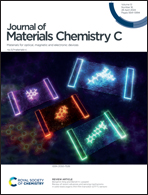Time-dependent phosphorescence color of carbon dots in boric acid matrix for dynamic information encryption†
Abstract
The ability to tune the color of time-dependent phosphorescence is very important. In this research, carbon dots (CDs) were synthesized with L-aspartic acid and boric acid through a one-step hydrothermal synthesis method. The CDs exhibit orange phosphorescence within 1 s after switching off 365-nm ultraviolet light and further change to green. The CDs have a long lifetime of 0.68 s and a quantum yield of 7.43%. By introducing halide ions into the CDs, CDs-X (X = F, Cl, or Br) have longer lifetimes of 0.83 s and higher quantum yields of 9.49%. However, the incorporation of iodine ions leads to a decrease in the quantum yield of the CDs and disappearance of the orange phosphorescence. This is because iodine ions expedite the carbonization process during the formation of CDs-I, resulting in a reduction in surface luminescent groups, thereby diminishing the quantum yield and orange phosphorescence of CDs-I and realizing regulation of the time-dependent phosphorescent color optical property of the carbon dots. Importantly, CDs and CDs-X (X = F, Cl, Br, or I) were successfully applied in anti-counterfeiting and multi-level dynamic phosphorescence color 3D coding information encryption.



 Please wait while we load your content...
Please wait while we load your content...